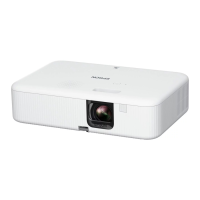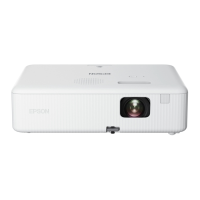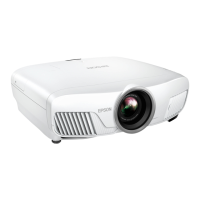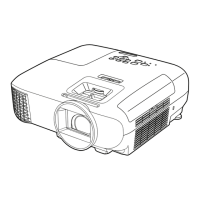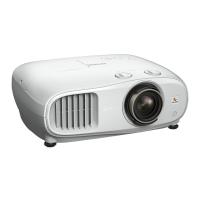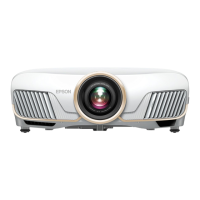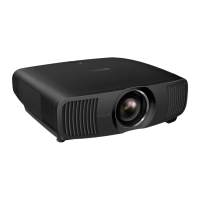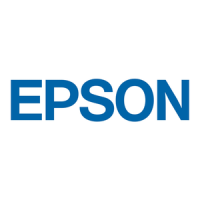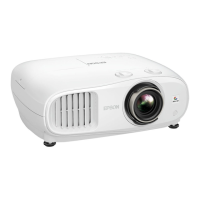
Do you have a question about the Epson CO-FH01 and is the answer not in the manual?
| Brightness | 3000 lumens |
|---|---|
| Contrast Ratio | 16, 000:1 |
| Light Source | Lamp |
| Projection Technology | 3LCD |
| Weight | 2.4 kg |
| Color Reproduction | Up to 1.07 billion colors |
| Projection Size | 30 - 300 inches |
| Resolution | 1920 x 1080 (Full HD) |
| Keystone Correction | Vertical ±30 degrees, Horizontal ±30 degrees |
| Connectivity | HDMI, USB |
| Speaker | 2W |
| Lamp Life | Up to 12, 000 hours (Eco mode) |
Explains graphical symbols and labels for safe projector use, including warnings and cautions.
Defines notations for procedures, additional information, buttons, menus, and related links.
Instructions on how to search the PDF manual using keywords within Adobe Reader.
Guide on navigating sections using bookmarks to jump directly to specific pages.
Steps to extract and print specific pages or ranges from the PDF manual.
Identifies and explains the parts located on the front of the projector unit.
Identifies and explains the parts located on the rear of the projector unit.
Identifies and explains the parts located on the base of the projector unit.
Details the buttons and functions of the projector's remote control for operation.
Advises on safety and environmental considerations for projector installation.
Specifies the required clearance around the projector for proper ventilation.
Outlines different ways to set up or install the projector for optimal use.
Explains how to operate the projector using the remote control effectively.
General guidance on connecting various video devices to the projector.
Instructions for connecting a video source via an HDMI cable for image and audio.
General instructions for connecting a computer to the projector for display.
Details connecting a computer via HDMI for video and audio output.
Explains connecting a computer via USB for video and audio using USB Display.
How to connect an iPad or iPhone to the projector via HDMI.
Guide for connecting external USB devices like drives, cameras, etc.
Projecting content directly from USB devices without a computer.
Steps to connect a USB device to the projector's USB-A port.
Procedures for safely disconnecting a USB device from the projector.
Instructions for connecting an Epson document camera to the projector.
Explains the Home screen's layout and navigation for source selection and features.
How to flip the image top-to-bottom using the remote control.
How to flip the image using the projector's menu system.
Adjusts image position when margins exist between image and screen.
Uses the H/V-Keystone function to correct uneven image shapes.
Uses the Quick Corner feature to correct uneven image shapes.
Steps to modify the displayed image's aspect ratio.
Lists the different aspect ratio options available for input signals.
Steps to change the projector's color mode via the remote control.
Lists and describes the various color modes available for projector use.
Instructions for installing the optional wireless LAN module.
Steps to manually configure wireless network settings on the projector.
How to select the correct wireless network on a Windows computer.
How to select the correct wireless network on a Mac computer.
How to use a QR code to connect a mobile device via Epson iProjection.
Lists the file types supported for PC Free presentations.
Important notes and precautions for using PC Free projection.
Steps to switch to USB source and start a slide show from a USB device.
Steps to switch to USB source and start a movie presentation from a USB device.
Options for customizing display settings in PC Free mode.
Explains different types of password protection available for the projector.
Steps to set a password for security features like Power On or Network Protection.
How to choose specific password protection types like Power On or Network.
How to enter the password to access the projector's functions.
Instructions for physically securing the projector using a cable.
Details the options available on the Web Control screen for projector management.
Explains Basic Control screen options for source selection and basic operations.
How to use the OSD Control Pad for menu navigation via mouse or touch.
How to select and project test patterns for display adjustment.
Describes the content of email alerts received for network projector issues.
How to navigate and use the projector's menu system to adjust settings.
Lists the types of text (numbers, alphabet, symbols) usable with the keyboard.
Configures basic network settings like projector name and passwords.
Selects and configures wireless LAN settings for network connection.
Details connection modes, SSID, security types, and channels for wireless LAN.
Configures email notifications for projector problems or warnings.
Configures other network settings, including command communication.
Resets all network settings to their default values.
Saves network settings and completes the configuration process.
Shows details about the projector and connected input sources.
Lists event IDs and their corresponding causes and solutions for network issues.
Copies projector settings to another projector using a USB flash drive.
Copies projector settings to another projector via a USB cable connection.
Notifies users of errors during batch setup and provides troubleshooting steps.
Basic troubleshooting steps for general projection issues.
Steps to resolve issues when the projector does not turn on.
Specific troubleshooting for when the projector lamp fails to illuminate.
Troubleshooting steps for unexpected projector shutdowns.
Steps to take when no image is displayed on the screen.
How to correct an unevenly rectangular projected image.
Steps to fix projected images that appear fuzzy or blurry.
Troubleshooting for situations where only a part of the computer image is displayed.
How to resolve projected images affected by noise or static interference.
Steps to fix projected images that flicker or are unstable.
How to correct images with improper brightness, contrast, or colors.
How to correct an image that is projected upside-down.
Troubleshooting for issues with the USB Display function.
Lists available optional accessories and replacement parts for the projector.
Details various mounting options for installing the projector.
Information on connecting the projector wirelessly.
Lists external devices compatible with the projector.
Details the types of connectors available on the projector.
Declaration of conformity with FCC rules for Class B digital devices.
EU regulatory information for manufacturer and importer.
UK regulatory information for manufacturer and importer.
Advisories on using the product in high reliability/safety applications.
Instructions for proper disposal of the projector, including mercury lamp.
Lists supported operating systems for the projector's features.
Legal notices regarding reproduction and liability for the publication.
Information about copyright ownership and the entity responsible for the guide.
